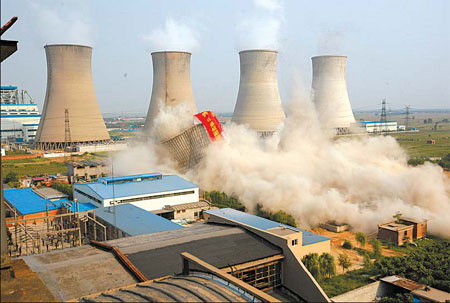Two State Council meetings in the past month have shown the authorities have intensified efforts to improve energy efficiency and the environment.
Before the official publication of the final report on energy saving and emission reduction in 2007, Premier Wen Jiabao held a meeting of State Council early July. Only three weeks later, another State Council meeting was held in Beijing with more detailed work priorities and plans.
The second meeting came after the Ministry of Environmental Protection blacklisted several provinces and autonomous regions including Guangxi and Shandong and power plants for their sluggish and ineffective action to achieve the central government's green target.

A power plant is being demolished in Xingtai, North China's Hebei Province in this September 6 2007 file photo. [China Daily] |
The official statistics was published in the middle of July, showing the country is still facing an uphill task in reaching its goal set in 2006 to cut total energy consumption by about 20 percent by 2010, as China saw only a 3.66 percent year-on-year decrease in energy consumption for every 10,000 yuan of GDP in 2007.
The State Council warned in the early-July meeting that energy-intensive and highly polluting industries should be resolutely curbed, and land-use, energy consumption and environmental impact assessment should be considered while approving new projects. A nationwide campaign of energy saving and emission reduction was launched at this meeting.
Tax on cars
In the July 23 meeting, the State Council agreed in principle to impose higher consumption tax on cars with large engines.
The plan was announced when Premier Wen Jiabao urged the government and the public to take more responsibility for saving electricity and fuel to ease energy pressures.
Energy-efficient cars would be given preferential tax treatment, according to a government statement.
The current consumption tax of cars is determined by their engine displacement. There are five grades of taxes. It's 3 percent for cars with 1 liter or less engine displacement and 20 percent for 4 liter or greater engine displacement.
When and by how much the tax will be adjusted is still being discussed. An industry insider predicts the 3 percent tax on cars with 1 liter or less engine displacement would be lowered to 1 percent, while tax on 4 liter or greater engine displacement would be increased to 40 percent.
China urgently needs to improve its energy efficiency as the international energy crisis is dragging down the economy, says Liu Wenge, director of Energy and Safety Division at China Coal Information Institute.
Progressive taxes would be a good model, allowing the government to utilize its economic levers to solve energy and environmental problems, he adds.
But as a way of promoting energy-efficient products, China's current taxation structure in the area of energy saving and emission reduction needs urgent adjustment, says Liu Huan, vice-director of Securities and Taxation Research Center at the Central University of Finance and Economics.
Tax policies should be fully exploited to encourage use of new energy-efficient technologies not only in cars, but also in air conditioners and other energy-consuming products, he adds.
Li Chunbo, an analyst with CITIC Securities, says the goals of energy saving and environmental protection can't be achieved by depending only on consumption tax adjustments. The government should ensure the entire car industry is engaged in the drive to save energy, working out relevant policies and requirements for different market segments.
"For instance, charging higher parking fees might be another way," says Liu with China Coal Information Institute. He emphasizes the government should guide manufacturers and consumers but shouldn't interrupt the functioning of the market.
Different from other policies, raising consumption tax on "big cars" is aimed at fundamentally changing the daily habit of the public, he says. "Chinese people still have room for improvement in their environmental awareness," says Liao Xiaoyi, director of Global Village, a non-government organization dealing with environmental protection based in Beijing.
Despite the increases in consumption tax and petrol prices, China Association of Automobile Manufacturers said that between January and June, the country sold 2.67 million cars, up 16.7 percent year-on-year. In addition, 224,300 SUVs were sold, up 42 percent.
Financial tools
Frank Liu, spokesperson for UN Global Forum, says the government action on "big cars" might sacrifice some economic interests, but in the long term, consumers and enterprises will benefit from it.
He suggests the government further adopt international financial tools to promote energy efficiency and improve the environment and the Clean Development Mechanism (CDM) in China.
Through such measures, local governments and enterprises will earn compensations as well as derive benefits from their energy-saving and emission-reduction actions, he adds.
At the July 23 meeting, the State Council also announced energy efficiency will be improved through comprehensive measures to reduce energy consumption of vehicles, heating and air-conditioning facilities and lighting.
The State Council also passed two draft regulations on energy saving measures for public institutions and residential buildings.
In mid-July, the National Development and Reform Commission (NDRC) reportedly begun drafting a subsidy scheme and invite suggestions from manufacturers on ways to effectively promote the use of more energy-saving air conditioners.
The authorities will also publish energy-efficiency ratings on electronic devices of eight categories at the end of this year and enforce it next year.
Electronic devices will be labeled with energy-efficiency ratings as a mandatory mark, enabling consumers to compare the energy efficiency of domestic appliances on a fair and equitable basis. It also provides incentives for manufacturers to improve the energy performance of appliances.
As Nobuo Tanaka, executive director of International Energy Agency, puts it: "Energy efficiency is the cheapest way to cut carbon dioxide emissions."